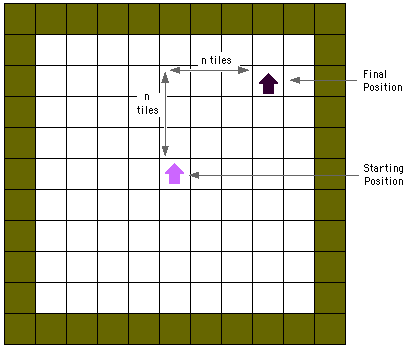
Supplemental Material for Baldwin and Scragg, Algorithms and Data Structures: The Science of Computing; Charles River Media, 2004 (Now published by Cengage Learning)
This exercise consolidates understanding of design, theoretical analysis, and experimentation by using all three to explore a simple problem.
Understanding of chapters 2, 3, and 4 of Algorithms and Data Structures: The Science of Computing.
The problem that this exercise explores involves making the robots introduced in chapter 2 of Algorithms and Data Structures: The Science of Computing move diagonally.
The robots are available through a Java class named Robot (and
a supporting class named RobotRoom). Programs that use these classes
need to include two Java files: Robot.java and RobotRoom.java. The “Final
Details” section of this document explains how to find these files
and their documentation.
Any Java source file that refers to the Robot or RobotRoom classes
should “import” those classes, via the statement
import geneseo.cs.sc.*;at the beginning of the file.
Within this exercise, moving a robot diagonally n tiles means establishing the postcondition that the robot is n tiles forward of the its initial position, and n tiles right of the its initial position. “Forward” and “right are both defined relative to the robot’s initial orientation. The robot should have that same orientation when it finishes moving diagonally. The diagram below illustrates these postconditions:

Assume as a precondition that there are no obstacles within n tiles forward and right of the robot.
At least two algorithms exist to move a robot diagonally under these definitions. One algorithm moves the robot n tiles forward, then n tiles to the right, as suggested here:
![[Robot Moves Forward Then Right]](img/lab-moi-2.gif)
The other algorithm alternately moves the robot one tile right, then one tile in the original forward direction, then one right again, and so forth until the robot is n tiles forward and right of its original position:
![[Robot Follows a Zigzag Path Forward and Right]](img/lab-moi-3.gif)
The exercise involves applying each of computer science’s methods of inquiry to the two algorithms for moving diagonally outlined in the “Background” section.
The algorithm explanations in the “Background” section capture
much of the insight behind designing algorithms to move a robot diagonally,
but they don’t address the details of implementing either algorithm.
Thus the first task is to write, in Java, a subclass of Robot that
handles two “move diagonally” messages: one, perhaps named moveDiagonally1,
is handled by the first algorithm, the other (perhaps named moveDiagonally2)
is handled by the second algorithm. Both messages take n as a parameter. Write
a main method
that tests both ways of moving diagonally.
The second task is to derive mathematical expressions for the number of primitive Robot messages
(move, turnLeft, turnRight, paint, okToMove, colorOfTile, heading)
that each of the methods for moving diagonally sends, in terms of n.
Finally, using the expressions for number of primitive Robot messages
in terms of n, form a hypothesis about how the execution times of
the two algorithms
will relate to each other. Be as specific as possible (e.g., it is better to
say “the first algorithm will take ten times longer than the second” than
to just say “the first algorithm will be slower than the second”).
Then, design and conduct an experiment to test this hypothesis.
While planning the experiment, keep in mind the elements of good experiment design discussed in chapter 4 of Algorithms and Data Structures: The Science of Computing. Some issues that may be particularly relevant in this experiment include…
Both Robot.java and RobotRoom.java can be downloaded from the Web.
Documentation on both classes is also available on the Web. The main documentation page is an index to documentation for all the Java classes written for use with Algorithms and Data Structures: The Science of Computing. To see the documentation for a specific class, click on that class’s name in the left-hand panel of the page.
Turn in a lab report describing your experiment. Format and submit this report as directed by your instructor.
Copyright © 2004 Charles River Media. All rights reserved.
Revised Aug. 8, 2005 by Doug Baldwin